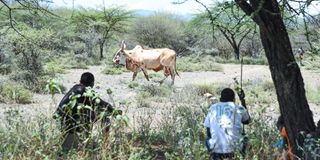Sh7.5 billion EU funding to ease life for drought-stricken Baringo

Men under a tree as a bull passes by, headed to Riongo Dam in Tiaty, Baringo County, the only water point in the semi-arid area on October 18, 2020. Livestock is the main economic mainstay in the region.
What you need to know:
- In Baringo County, EU is targeting to contribute over Sh655 million in a scheme that will promote secure and sustainable sources of income among pastoral and agro-pastoral communities.
- The four-year project dubbed Baringo resilience initiative, is targeting to improve the livelihoods of over 60,000 farmers in Tiaty, Mogotio, Baringo North and Baringo South Sub-Counties through access to extension services and diversified farming systems.
- It is implemented by Self Help Africa to improve livelihoods where food production has been affected by climate change.
- EU ambassador to Kenya Simon Mordue said they are committed to fighting drought emergencies in Africa.
Locals in arid and semi-arid areas in Kenya are set to benefit from Sh7.5 billion funding from the European Union aimed at mitigating against drought and related effects.
In Baringo County, EU is targeting to contribute over Sh655 million in a scheme that will promote secure and sustainable sources of income among pastoral and agro-pastoral communities.
The four-year project dubbed Baringo resilience initiative, is targeting to improve the livelihoods of over 60,000 farmers in Tiaty, Mogotio, Baringo North and Baringo South Sub-Counties through access to extension services and diversified farming systems.
It is implemented by Self Help Africa to improve livelihoods where food production has been affected by climate change.
While commissioning the project at the Kenya School of Government in Baringo County, devolution cabinet secretary Eugene Wamalwa said arid and semi-arid regions have over the years grappled with great risk of losses resulting from hazards such as extreme droughts and floods.
Far from achieving food security
He said the government is focused on tapping the huge unexploited potential of drought-prone areas in terms of both food production and business growth.
“Recurrent droughts, flooding and landslides that we are witnessing in several parts of the country underscore the need to address vulnerabilities in arid and semi-arid areas to ensure increased crop and livestock production, enhanced food and nutrition security and access to markets as part of building the resilience of the pastoral and agro-pastoral communities,” said Mr Wamalwa.
He, however, raised concern that factors such as insecurity and conflict, high population growth, weakening community institutions and limited education opportunities are undermining food security and livelihoods in the ASAL regions.
“One of the pillars under the government’s ending drought emergencies strategy is focusing on strengthening the resilience of livelihoods. Through the Big Four Agenda, we are fast-tracking fulfillment of the promise of 100 percent food security for all Kenyans through a coordinated approach between relevant departments, agencies, and county governments,” said the Cabinet secretary.
He said the government had put in place special programmes and mechanisms to address stunting and malnutrition which are rampant in arid areas.
“It’s highly regrettable that the rate of stunting in the region’s children stands at an alarming 39 percent and we are still far from achieving food security for all,” said Mr Wamalwa.
Mitigated by human action
He said by strengthening institutional capacities for drought risk reduction and protection against asset loss will contribute significantly towards ending drought emergencies.
“We must embrace innovation and modernise our project interventions for us to attain food and nutrition security, and tackle climate change,” said Mr Wamalwa.
EU ambassador to Kenya Simon Mordue said they are committed to fighting drought emergencies in Africa.
“While droughts may be an unavoidable natural phenomenon in the Horn of Africa, their impact can be mitigated by human action. Droughts should not lead to famine and other disasters,” said Mr Mordue.
Self Help Africa Executive Officer Ray Jordan said the project would adopt a range of climate-smart ways to develop strategies that will achieve food and nutrition security and reduce poverty levels in target areas.
The Baringo resilience initiative which targets more than 10,000 households will be implemented by Self Help Africa, Farming Systems Kenya and Sustainable Agricultural Initiative Network (SAII).
Economic mainstay
Baringo governor Stanley Kiptis lauded the project saying it would greatly contribute to the county disaster preparedness, food and nutrition security for a sizeable number of vulnerable households.
Baringo county government has also partnered with European Union to construct a Sh289 million Maoi slaughterhouse in Mogotio.
Livestock sector is expected to take the first lane from the grant which will attract investment in cottage industries on meat bi-products.
“The project will make the county at the forefront to compete with other regional and international markets which will see our meat being branded and certified for quality and safety for sale,” said Mr Kiptis.
He said the county government has positioned itself to reap fully from the livestock sector which is the economic mainstay of the area with the county being rated second in the country after Turkana County with an estimated two million goats and one million cows.





